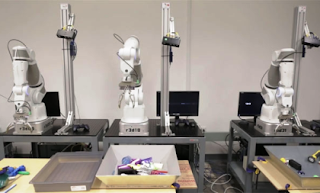Google may have already sold Boston Dynamics, but it doesn't mean that the tech giant is not interested in staking a claim in the growing robot business. Just ask its room full of robotic arms. It’s about more than just making a good robot arm, though. It’s also about teaching a robotic arm tactile learning skills.
Essentially, Google outfitted the arms with basic optical sensors and a neural network, or artificial brain capable of learning. The robot was then tasked with finding specific objects in a pile, and learning how best to grasp them in order to move the object. This is easier said than done, given that it’s a skill even humans gradually acquire. The researchers said it's essentially hand-eye coordination.
At the end of every day, the researchers took the data collected during the robots' attempts and used it train neural networks to better anticipate the outcome of a grasp. Over the course of 800,000 grasp attempts, the networked arms were able to start self-correcting their actions.
Soon enough they were picking up objects with much more frequency, even employing what might be observed as strategies—such as pushing an object away in order to grasp another and developing different techniques to pick up soft versus hard objects.
All of this took place without the researchers programming the system how to pick these objects up. Using a feedback loop, they were able to reduce the rate of failed attempts to pick up an object down to 18-percent. The researchers plan to expand their research to a wider variety of grasping strategies, and later try the approach in a variety of environments and real-world scenarios outside of the lab.
The goal is a robot that could automate sorting tasks. This could be a bot designed for warehouse work, or one that could sort through single stream recycling to pick out glass bottles and aluminum cans from other items in the bin. Regardless, granting machines spatial reasoning and the ability to learn and adapt to objects could be a big boon going forward, with bots able to adjust its grasp for as hard or as light as the job necessitates.
Essentially, Google outfitted the arms with basic optical sensors and a neural network, or artificial brain capable of learning. The robot was then tasked with finding specific objects in a pile, and learning how best to grasp them in order to move the object. This is easier said than done, given that it’s a skill even humans gradually acquire. The researchers said it's essentially hand-eye coordination.
At the end of every day, the researchers took the data collected during the robots' attempts and used it train neural networks to better anticipate the outcome of a grasp. Over the course of 800,000 grasp attempts, the networked arms were able to start self-correcting their actions.
Soon enough they were picking up objects with much more frequency, even employing what might be observed as strategies—such as pushing an object away in order to grasp another and developing different techniques to pick up soft versus hard objects.
All of this took place without the researchers programming the system how to pick these objects up. Using a feedback loop, they were able to reduce the rate of failed attempts to pick up an object down to 18-percent. The researchers plan to expand their research to a wider variety of grasping strategies, and later try the approach in a variety of environments and real-world scenarios outside of the lab.
The goal is a robot that could automate sorting tasks. This could be a bot designed for warehouse work, or one that could sort through single stream recycling to pick out glass bottles and aluminum cans from other items in the bin. Regardless, granting machines spatial reasoning and the ability to learn and adapt to objects could be a big boon going forward, with bots able to adjust its grasp for as hard or as light as the job necessitates.


No comments:
Post a Comment